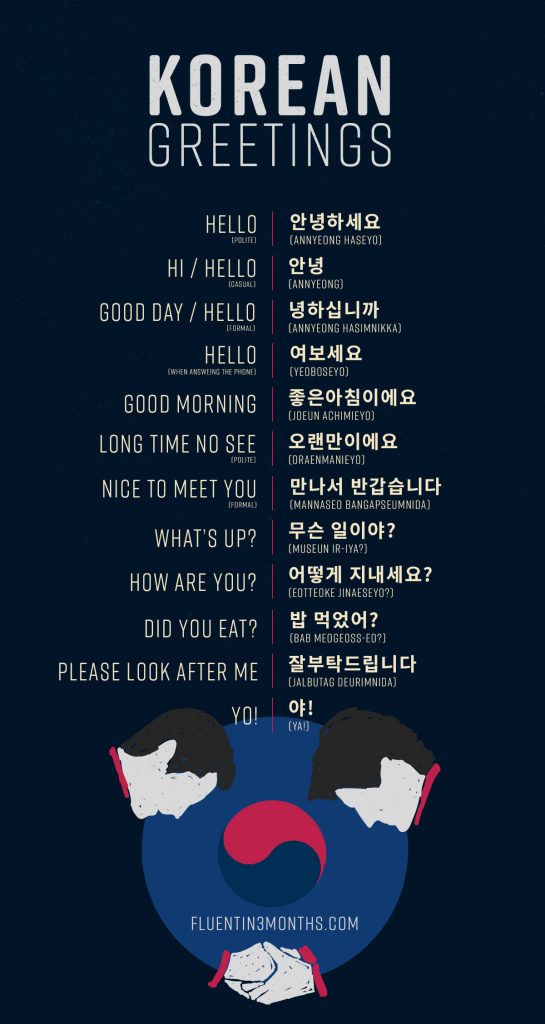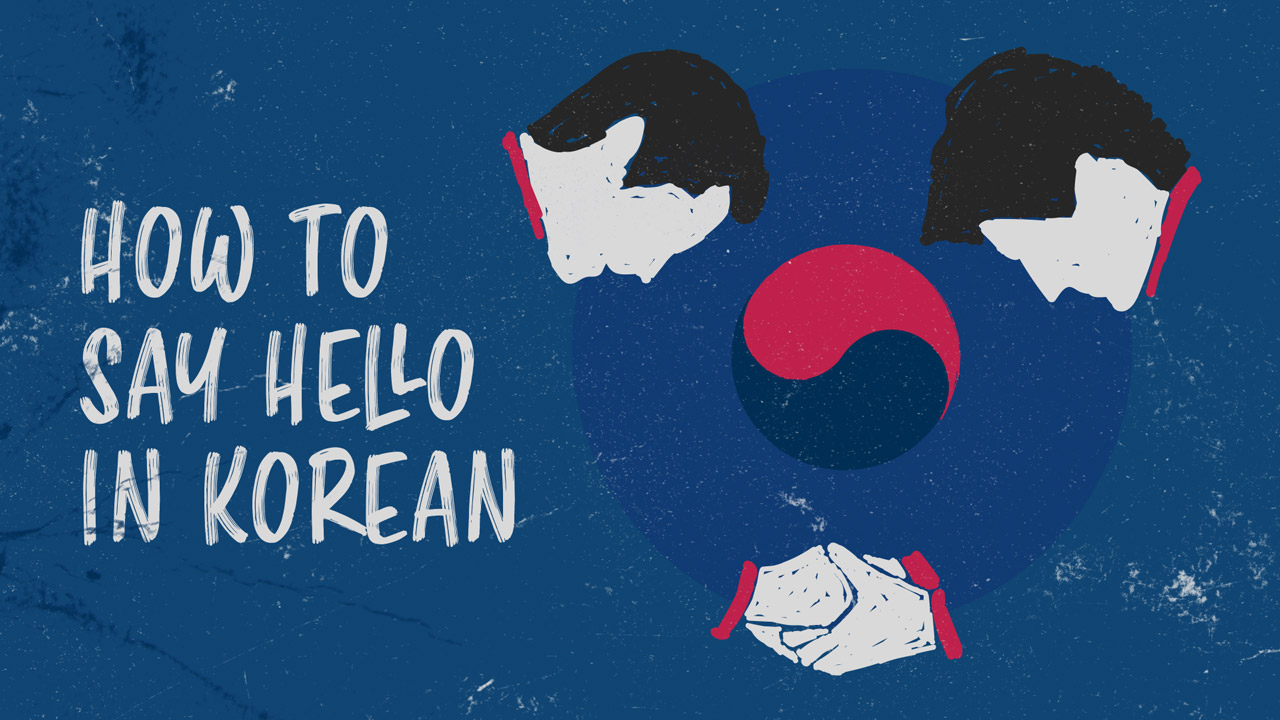Korean Greetings: 10+ Ways to Say “Hello” in Korean
Having your first conversation in Korean starts with a simple “hi”. And that’s why you need to learn “hello” in Korean, as well as some basic Korean greetings!
Learning how to say hello in Korean is pretty simple, and you may even have heard it before…

Long before I had an interest in learning the language, I learned how to say “hello” in Korean while watching Arrested Development. If you’ve seen the show, you might remember they thought “Annyeong” was his name, but it really meant hello (which is why he was always saying it).
The Bluths’ mistake was my memory gain!
But saying hello has a bit more to it than that. The Korean language has a hierarchy of formality based on who you’re talking to.
But no worries! I’ll fill you in on all the details so you can start having conversations in Korean with ease.
To get you started though, here’s a quick list of Korean greetings:
- “Hello” (polite): 안녕하세요 (annyeong haseyo)
- “Hi” / “Hello” (casual): 안녕 (annyeong)
- “Good day” / “Hello” (formal): 녕하십니까 (annyeong hasimnikka)
- “Hello” when answering the phone: 여보세요 (yeoboseyo)
- “Good morning”: 좋은아침이에요 (joeun achimieyo)
- “Long time no see” (polite): 오랜만이에요 (oraenmanieyo)
- “Nice to meet you” (formal): 만나서 반갑습니다 (mannaseo bangapseumnida)
- “What’s up?”: 무슨 일이야? (museun ir-iya?)
- “How are you?”: 어떻게 지내세요? (eotteoke jinaeseyo?)
- “Did you eat?”: 밥 먹었어? (bab meogeoss-eo?)
- “Yo!”: 야! (Ya!)
- “Please look after me”: 잘부탁드립니다 (jalbutag deurimnida)

How to Say Hello in Korean
First, let’s talk about that formality thing. In the Korean language, there are seven levels of formality, although you only need to know the main levels.
They are: casual, polite, and formal/honorific.
The other levels are mostly outdated. They’re good to know if you want to read religious scriptures or watch intense Korean period-dramas, but you won’t hear them in everyday life.
Casual speech is for when you’re speaking with friends, family, and those younger than you or of lesser seniority.
Polite speech is for when you’re speaking with people you know, but not very well. This level of speech allows for social distance (you aren’t saying you’re higher or lower than them), and it’s pretty neutral.
Polite speech is going to be your go-to in many situations.
You should use formal speech with strangers or in formal situations, such as introducing yourself. You would use this with people who are older than you or higher seniority.
So, for example, a boss would use polite speech with his employees because he's the superior. But employees would use formal speech with their boss. You would use casual speech when talking with your spouse, but polite speech when talking with a coworker.
It’s important to know these levels of formality so when you learn the phrases below, you know when to use them correctly and why there are variations for the same thing.
Korean can be easy to learn once you understand some of the basics like this.
Okay! That’s out of the way. Let’s learn some Korean greetings.
I’ll write them in both Hangul (Korean characters) and romanized letters. But it’s best to learn Hangul for proper pronunciation. In fact, you can learn Hangul in just a few minutes.
안녕하세요 (Annyeong Haseyo) – “Hello”
This is your most common way to greet someone in Korean. It’s the familiar, polite speech pattern.
You use 하세요 (haseyo) to show a bit of extra respect. 하세요 comes from the verb 하다 (hada), which means “to do.”
It’s a good phrase for almost all situations, especially if you’re unsure what level of formality to use.
You can say this to introduce yourself, to show respect to those older than you, and in the office. If you add a question mark or use raised tonation on the last syllable, it means the same thing as “How are you?” Like:
“안녕하세요?” (Annyeong haseyo?, “Hi, how are you?”)
“예. 안녕하세요?” (Ye. Annyeong haseyo?, “I’m well. How are you?”)
It’s normal to bow a little when you greet someone with this phrase.
Bonus fun fact: 안녕하세요 literally means “are you at peace?” which is why the standard response back is “yes” or 예 (ye).
안녕 (Annyeong) – “Hi”
안녕 (annyeong) is your informal, casual way to greet those you’re close to, such as friends and family.
What’s nice about 안녕 (annyeong) is that it’s used in many ways. Unlike other languages, Korean doesn’t have phrases for different times of the day. Although there is a “good morning” phrase (which I’ll show you later), you won’t hear “good afternoon” or “good evening.”
So, 안녕 (annyeong) is a good one to know because you can use it at all times of the day, and even to say goodbye.
This informal version is also the building block for adding the more polite parts of the word, like how you add 하세요 (haseyo) to be more polite.
안녕하십니까 (Annyeong Hasimnikka) – “Good Day”
Okay, so the literal translation is still “hello” in Korean. But I’m going to explain it as “good day” or even “good day Sir/Madam” because I think of it as a super formal, almost awkward way to greet someone.
These days, it’s only used on the news, or when greeting customers to show a high level of respect.
This is the honorific, formal form, and one of the most polite that’s still in use. You probably won’t say it yourself, but it’s good to know because you may sometimes hear it.
여보세요 (Yeoboseyo) – “Hello”
Yes, another way to say “hello,” but this one has nothing to do with formality.
You only use 여보세요 (yeoboseyo) when you answer the phone. If you’ve ever studied Japanese greetings, it’s like saying もしもし (moshi moshi).
여보세요 (yeoboseyo) can also be used very informally to get someone’s attention, like saying “Look over here!”
It’s almost exclusively used over the phone, or if you’re calling out “hello” and unsure who you’re talking to or if anyone is there.
좋은아침이에요 (Joeun Achimieyo) – “Good Morning”
좋은아침이에요 (joeun achimieyo) is the polite form, while 좋은아침 (joeun achim) is the casual form for greeting close friends.
While this means “good morning,” and you will sometimes hear it, it’s not as common as it is in English. 안녕하세요 (annyeong haseyo) is still a much more common greeting, at all times of the day.
오랜만이에요 (Oraenmanieyo) – “Long Time No See”
If you haven’t seen someone in a while, you can use this phrase as a greeting, like you would in English.
You can adjust it to be informal for close friends by saying 오랜만에 (oraenman-e). Or to be more formal (like to your boss), use 오랜만입니다 (oraenmanimnida).
Note: The “e” ending or the basic form of the verb is least formal, “ieyo” ending is polite, and the “nida” ending is most formal in common speech.
만나서 반갑습니다 (Mannaseo Bangapseumnida) – “Nice to Meet You”
Like in English, you can greet someone you’re meeting for the first time with “nice to meet you” instead of “hello.” The most common way to say it is 만나서 반갑습니다 (mannaseo bangapseumnida), which is in its most polite “nida” form.
It's one of the few set phrases you'll hear often in that formality almost exclusively. Because, in general, when meeting someone for the first time, you’ll use formal speech like this.
But, in more casual settings, you could also say 만나서 반갑습이에요 (mannaseo bangapseum-ieyo) which is “It’s nice to meet you.”
More often though, you leave off the first half and say 반갑습니다 (bangapseumnida). Kind of like “Nice to meet ya.”
무슨 일이야? (Museun Ir-iya?) – “What’s up?”
Here’s a slangy greeting for you to use with friends! You can use 무슨 일이야? (museun ir-iya) to greet someone or ask what they’re doing, like in English. But you wouldn’t use this phrase with people outside your social circle.
You can also add 이게 (ige) to the beginning of the phrase to say 이게 무슨 일이야 (ige museun ir-iya), “What’s happening?”
어떻게 지내세요? (Eotteoke Jinaeseyo?) – “How are you?”
While you can use 안녕하세요? (annyeong haseyo?) to ask how someone is doing, it more literally means, “are you at peace?”
So to be more direct and get a real answer out of someone, you ask 어떻게 지내세요? (eotteoke jinaeseyo?) instead.
With friends, you could say 요즘 어때? (yojeum eottae?) which is a very casual way to say “What’s up,” “How’s it going?” or “How are you?”
But there’s also the phrase 밥 먹었어? (bab meogeoss-eo?), meaning “Did you eat?” You’ll hear it often because friends don’t let friends miss out on good meals.
야! (Ya!) – “Yo!”
If you’re calling out to your friends, you can grab their attention with “야!” (ya!)
It’s pretty slangy, and a bit masculine. You can only use this one with close friends the same age as you, and it can also be used to exclaim “Wow!” or “Hey!”
잘부탁드립니다. (Jalbutag Deurimnida) – “Please look after me.”
Translated literally, it means “thank you very much (for doing as I asked/taking care of it).” And it is used in that way sometimes, but more often, you’ll hear this as a respectful greeting to go with introductions.
It’s a cultural thing, but it means something like “please let’s have a good relationship” or “please look after me.”
It’s also used like “I ask this of you, so please take good care of it.” So if you were to drop off your child at school or daycare, you would say 잘부탁드립니다 (jalbutag deurimnida) to ask them to take good care of your child.
It’s very polite and usually said with a bow.
Which Korean Greeting Will You Use?
You’re one step closer to starting your first conversation in Korean!
If you’re ready to start learning more, check out these 35 free Korean resources. You can also check out founder of Fluent in 3 Months Benny Lewis' favorite Korean resources.
My favorite resource? 90 Day Korean.



Social